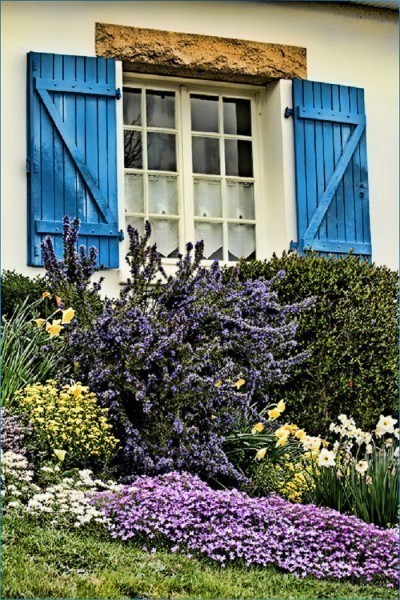






When planning a garden design, start with a basic idea and look to the surrounding landscape and hardscape features for further assistance. For instance, if your kids are anything like mine, they probably have a worn-out path somewhere in the yard as a result of taking the same route each day. Consider using this to your advantage by adding a layer of mulch, gravel or other hardscape feature to the pathway.
Another example might be the inability to grow particular plants in specific areas, like beneath a large shade tree. If this is the case, simply amend the soil and add shade-loving plants. If this is not an option, place a small table and chair there instead. Now you have an attractive place to relax. You could even add the same type of mulch or gravel here as with the path.
Closely examine the architecture of your home and determine the style. For example, is it a ranch, cottage, modern, or log home? Some of the best garden designs are created with the home as its main feature.
Homes constructed from logs or other natural elements are commonly accentuated with informal garden designs. Typically, these are laid out with flower beds, trees and shrubs that are located in the front, greeting visitors with a warm welcome. The use of evergreens, flowering shrubs and plants of various colors, forms, heights and textures will create a suitable setting. Cottage-style homes are included here since flowers, herbs and vegetables are commonly grown together within this type of garden design.
Those having more traditional or modern homes should focus on more formal garden designs. Plantings are less casual and restraint is practiced when ornamental features (benches, fountains, arbors, etc.) are implemented. Formal garden designs typically include patterns in flower beds and carefully pruned shrubs or hedges.
When you are ready to choose plants for the garden, once again, look to the surrounding landscape, the exterior of your home (trim, shutters, roof) and other hardscape elements for guidance. For instance, is your home brick colored, white vinyl siding, or perhaps natural-colored stonework?
Color has a major impact on how people feel and relate to the world around them. This is also true when it comes to our garden surroundings. The colors you choose will ultimately unify the house with the garden, and both should blend easily into their surroundings. Choose flowers in the same color family as well as those that complement them. Yellows, for example, blend well with golds, oranges and reds. Complement these with shades of purple or violet.
Also, keep in mind how certain colors work. Cool colors, like blue or purple, should not be placed in dark areas or far away, as these colors tend to fade into the landscape. Warm or hot tones, such as yellows and reds, should be used to brighten drab areas instead. These colors grab attention and are best placed at a distance to bring them closer. Foliage also provides color and interest.
Trees, shrubs and foliage plantings should be carefully considered. Landscapes heavily loaded with evergreens may not offer much in the way of seasonal interest; therefore, adding small trees and shrubs to the design will provide striking leaf color during off seasons. Visual interest should also take into account the differences in bark texture and branch patterns. Repeating the same textures will pull everything together, helping to connect the garden with its surroundings.
There are other considerations when planning a garden. Does the existing layout of the home include a porch or walkway? If so, are they straight or curved? Does a patio or deck already exist? What are these made of? What about the driveway? Is it gravel or pavement? Black asphalt gets hot in summer so keep plantings away from its edges to prevent plants scorching.
Also, consider the location of your home within the garden surroundings. Is it nestled discreetly in a wooded setting or in an open lot? How close to the road is it? What about the neighbor’s property? All of these factors need to be taken into consideration when planning a garden design. Proper planning is essential in order to connect the garden with its surroundings.
An Idea is the Biggest Challenge
Be Fascinated With the Wonders of Small Japanese Garden Design for Your Home
Welcoming Wildlife In The Garden: How To Create A Wildlife Garden
The Development of Garden Flowers
Mice: How to Identity and Get Rid of Mice in the Garden and Home
Copyright © www.100flowers.win Botanic Garden All Rights Reserved